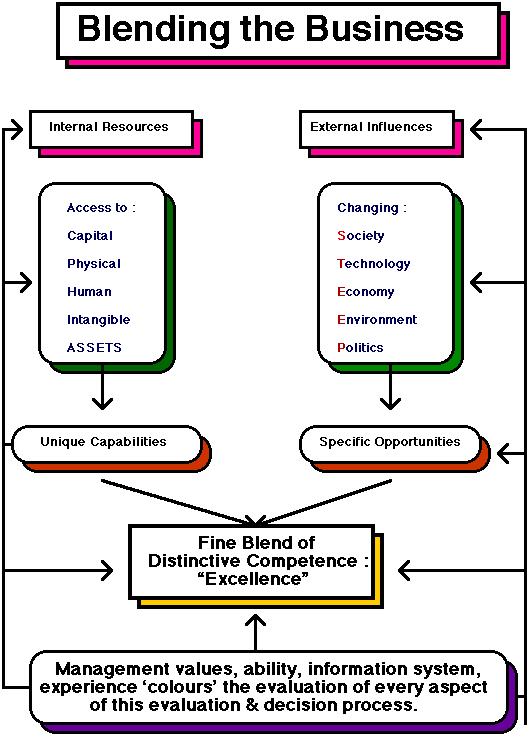Block 2. Business Environment
 Q. What are the ‘drivers’ and ‘influencers’ of business activity?
Q. What are the ‘drivers’ and ‘influencers’ of business activity?
A. It is all about the ‘environment’ in which the organisation exists and how it ‘reads‘ and responds to that environment.
Essentially the answer lies in changes occurring over time (hence the clock pic) in a number of ‘environments’ (socio-cultural, technological, economic, natural, political, legal/regulatory, consumer & competitive) , which evoke responses from us in our professional & personal capacities and from governments & organisations.
This Block will be about:
- researching these environments – what is happening now and is set to happen in the near and longer term futures? What trends and ‘megatrends‘ can you see/feel/predict?
- determining the impacts and implications (opportunities and threats) of these changes and trends for certain existing companies and organisations and identifying appropriate strategic responses
- developing ideas for NEW products and services (commercial or public sector) which could well be needed, demanded and successful responses to the changes and trends identified.
This may all seem a bit ‘abstract’, but it isn’t:
Let me give you a couple of examples. Think for a minute.
- If you were in the Tourism and Travel industries what if there were an outbreak of H1N1 influenza in Paris and London…..? Would your American target market be likely to book a European tour? If you dealt exclusively with Europe as a destination you could find yourself with virtually no business….. (A social / health environmental factor / driver).
- What about BREXIT – is that going to help Tourism to France by the British who are France’s biggest international market by far? (A political driver)
- Looking back for a minute, what gave rise to the dramatic growth of Low-Cost airlines…? The sudden and largely unpredicted arrival of the internet. It allowed such airlines to come into being and prosper without the need to print brochures and operate through a costly, commissioned network of agents/ intermediaries. The technological innovation allowed the low cost sector to proliferate whilst the traditional airlines were ‘stuck’ with their traditional, costly, distribution network AND having, at the same time, to fund the development of their own internet presence. (A technological ‘driver’).
These are just illustrations – they are FAR from representing all possible drivers….. so, after the ‘Aside’ (A little, incidental digression) directly below, you will find further details and task instructions.
——————————————————————————————————————————
[An ‘Aside’: Do you know where the internet came from / who developed the idea, where, why, when and how? Exactly who came up with the idea and invented HTML code and links in a page? Think: it wasn’t so long ago – there was a moment where it didn’t exist – someone did something – it came into existence – the world depends upon it! Imagine if you had to pay a penny every time you clicked on a link .. and how rich the inventor could have made himself. Some clues for you:
- France had a (sort of) ‘hand in it’
- No, it wasn’t the American defense system or ARPANET!
- There is a (very tenuous) connection to me and my wife
- The idea emerged after an end of placement (fr: ‘stage‘) restaurant meal, lamenting the fact that the group of departing stagiaires would be out of real-time contact with one another and scattered all over the world rendering continued collaboration annoyingly difficult)
- The idea came into being less than 300km from Mulhouse
Anybody know the story?
So, if a frustrating problem + a stagiaires meal = a world-changing moment…. surely anything is possible! (The website Lastminute.com was developed by a pair of students during their degree programme, for example)
—————————————————————————————————————————–
A Conceptual Representation of the organisation
in its environment.

Things you should notice from the above:
- The ‘Business’ being blended doesn’t have to be commercial: one could equally imagine a public or voluntary sector organisation or things like a region, say the ‘Grand Est’ or Paris as a tourist destination.
- The ‘External’ side is effectively the O+T of SWOT (Strengths, Weaknesses, Opportunities and Threats).
- The ‘Internal side represents the S+W of SWOT
- Although organisations are looking to seek an equilibrium between capabilities and the opportunities – the equilibrium should be dynamic not fixed because all the internal and external components are permanently in motion. The validity of an organisation’s ‘equilibrium position’ should be permanently under review and shift as naturally as possible in response to change.
- Although the STEEP external factors are shown as separated (for reasons of simplicity), clearly they are not – they are closely related, each affecting the other: one can easily see that Technology affects Society and the Economy for example.
- I did not include in the model, certain of the ‘environments’ I mentioned above (competitive, consumer, legal/regulatory) because most of you will already know the STEEPL / PESTLE model as it stands.
- There is no computerised ‘correct’ solution to selecting the equilibrium position: Even in situations which managers have similar information in their hands about drivers of change they often make completely different decisions. [Tony: Bungee-Jumping (sauter à l’elastique) role play]
So: Your Task: Trends in Today’s Business Environment
We need teams of equal size for this task. As this is the first time I have taught AES, I am not sure of the cohort size. I am guessing 20 in each seminar group so perhaps 4 per team. You will need to work together and to work online. One team for each environment specified below: no duplication permitted!
Team 1. identify and consider current and forecast changes in the socio-cultural business environment and the opportunities and threats they may bring for new and existing businesses.
Team 2. identify and consider current and forecast changes in the technological environment and the opportunities and threats they may bring for new and existing businesses.
Team 3. identify and consider current and forecast changes in the economic environment and the opportunities and threats they may bring for new and existing businesses
Team 4. identify and consider current and forecast changes in the natural/physical environment and the opportunities and threats they may bring for new and existing businesses
Team 5. Identify and consider current and forecast changes in the legal/regulatory environment (in France, but you can include European legal/regulatory changes set to be enacted in France)
THEN... Once each team has researched current and forecast change in the business environment for which it is responsible, it must then consider:
- the impacts and implications of such changes for businesses in general
- how specific businesses might respond to such changes and their consequent opportunities and threats. NB. To achieve this, it might help to imagine a range of particular businesses and how they might be affected, for example (but you may choose others):-
- Club Med or Marriott Hotels.
- easyJet / Ryanair or Air France
- PSA / Renault or BMW
- l’Oreal or Chanel
- MacDonalds or Quick
- Carrefour or Cora
- New York or Paris as tourist destinations
OUTPUT REQUIRED. at the end of this block (in class, date TBA) each team must deliver:
- an oral presentation (no more than 10 minutes) accompanied by Powerpoint, Prezi or Word projection or just a handout – whatever you feel will have greatest impact.
- All team members will play an equal part in the oral presentation (no-one can stay silent and work the PC….sorry!).
- The presentations will comprise a number of parts:-
- an ‘intro’ to the topic and the structure of the presentation (what you will do and how you will do it)
- the dynamics of the business environment you are studying (what is changing…trends:- in what direction and how fast etc)
- the potential impacts and implications (i.e. the opportunities and threats) of change in the business environment generally and for a particular business/organisation
- recommendations as to what this business/organisation might do in order to seize the opportunities and neutralise the threats you have identified.
- As many brainstormed ideas as possible for new products and services which might be welcome, needed and successful in the future as a result of your research.
- An ‘outro’ slide to round off the presentation effectively.
ASSESSMENT. I will assess this oral presentation and the associated support material. I will award a base mark for the team (but reserve the right to moderate this base mark upwards or downwards for particularly impressive or weak contribution/performance by individuals).
LINK TO BLOCK 3. You will develop and refine your new products / services ideas and assess each one in terms of feasibility, viability, complexity/simplicity and timing, then select the very ‘best’ one and develop a plan to realise your concept and ‘pitch’ it to the Dragons in the Dragons’ Den to (hopefully) generate the finance. See Block 3 details.

